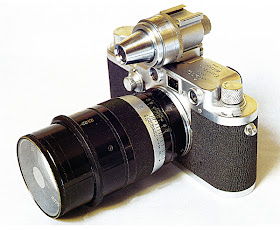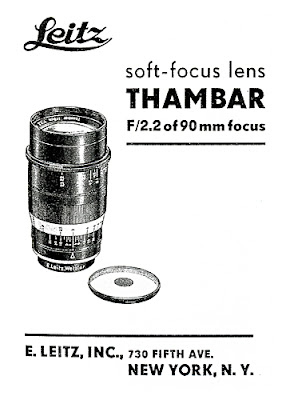From the very beginning,
Leica lenses have always had a very high reputation for their sharpness and
their special tonal performance. This
was a prerequisite, demanded by Oskar Barnck and realized by Max Berek with even
his first lens designs for the Leica.
As a matter of fact, Leitz
had been criticized from time to time for not having any good portrait
lenses. Many Leica users thought that
the Leica lenses were often too sharp for portrait work. That gave the impetus for Max Berek to design
the Leitz Thambar at the beginning of the 1930s.

The Thambar was a soft
focus lens, displaying some rather unique characteristics, which made it one of
the premier portrait lenses of the time.
The soft focus effect was the result of the lens having been purposely
designed with a considerable amount of residual spherical aberration. The name Thambar was derived from Greek,
meaning “something that inspires wonder”, or wonderful. The lens was comprised of four elements, with
the two central elements cemented to form one group. A very similar formula was later chosen for
the 125mm Hektor for use on the Visoflex.

Leitz Thambar on a Leica
IIIc with VIDOM viewfinder
The spherical aberration
of the lens was produced primarily at the outer perimeter of the lens. Stopping it down to smaller apertures would
reduce this effect and it was totally eliminated at f/9. To further enhance the soft focus effect, the
lens came supplied with a special, clear filter that had a one centimeter
mirrored spot in the center which eliminated the sharp image created by the
center of the lens.

Element configuration of
the Thambar with installed filter on left

Leitz New York Thambar
brochure
The maximum aperture of
the lens was f/2.2. This was reduced to
f/2.3 with the center spot filter in place.
For that reason the Thambar had two aperture scales, one in white for
the f/stops without the filter and one in red for the stops with the filter
installed. The red scale went from f/2.3
to f/6.3 because above f/6.3 the filter became useless. The maximum soft focus effect was obtained
with the lens wide open and with the filter installed. Stopping the lens down would diminish this
effect, thus giving the photographer full control over the amount of soft
focus. Photographing with back lighting
or lighting that produced flare would further increase the soft focus
effect. The distance of the subject also
had a significant effect on the softness.
The Thambar actually was
relatively difficult to use because the rangefinder of the camera did not allow
the soft focus effect of the lens to be seen.
Subsequently a fair amount of experience was necessary to use the lens
effectively.
The production of the lens
started on 1935 and ended in 1949.
According to company records, about 3000 lenses were produced. Today the Thambar is one of the most sought
after pieces by Leica collectors. Even
though a production of 3000 lenses is not all that rare, it is difficult to find
complete sets with the original filter, and sets complete with the filter and
the original red boxes are quite rare.
The Thambar is indeed a legendary piece of equipment among Leica
enthusiasts.
___________________________________________________________________________
To comment or to read comments please scroll past the ads below.
To comment or to read comments please scroll past the ads below.
All ads present items of interest to Leica owners.
HOLIDAY GIFT IDEAS FOR THE LEICA ENTHUSIAST
Click on image to enlarge
Order: info@gmpphoto.com
Click on image to enlarge
Order: info@gmpphoto.com
Click on image to enlarge
Order: info@gmpphoto.com
HOLIDAY GIFT IDEAS FOR THE LEICA ENTHUSIAST
Click on image to enlarge
Order: info@gmpphoto.com
Please make payment via PayPal to GMP Photography
Click on image to enlarge
Order: info@gmpphoto.com
Please make payment via PayPal to GMP Photography
Click on image to enlarge
Order: info@gmpphoto.com
Please make payment via PayPal to GMP Photography










Dies ist bestimmt ein sagenhaftes Objektiv. Ich finde es vor allem interessant das es mit seinem Alter immer noch sehr gebrauchsfähig ist und gut zu jeder Leica Ausrüstung passt.
ReplyDeleteHere is a translation of the above comment:
DeleteThis is indeed a legendary lens. I find it especially interesting that the lens is still very useful in spite of its age and that it would fit very well with any Leica equipment.
So this lens essentially was designed to deliver blurred photographs.
ReplyDeleteThere is a huge difference between a soft focus and a blurred image. Blurred pictures are just that, blurred, while a soft focus image does show most of the detail, but it is, for lack of better expression, overlaid with an image that is blurred to varying degrees.
Delete